Site Menu:
| This is an archived Horseadvice.com Discussion. The parent article and menus are available on the navigation menu below: |
| HorseAdvice.com » Diseases of Horses » Lameness » Joint, Bone, Ligament Diseases » Epiphysitis, Physitis, and Physeal Dysplasia » |
| Discussion on Leg deformity at birth | |
| Author | Message |
| New Member: kshayden |
Posted on Tuesday, Jun 3, 2008 - 10:48 am: Hi, I have read the articles and would love to hear more feedback about my little guys specific issues. Mare on pasture, but current DrOught conditions - little nutrition. Fed grass/clover hay - 2 lbs LMF development (G) with added calf manna and 'special' California mineral supplement once a day.Foal born 13 days premature. Colt. Severe contracted tendons from knee down (looked like a walking spider), lacked sucking reflex. Normal birth (surprisingly). Foal up right away but couldn't balance to nurse. Very strong. Attending vet gave tetracycline within 2 hours of birth, tube fed and splinted (1/2 splint on worse leg on backside of leg) only splint she had with her. Vet said huge foal, extremely large placenta for size of mare (stocky 15h QH). Foal taken to neonatal care facility at 12 hours old -different vet put full splints (just below elbow to floor on front side of legs) treated for fever and infection (unknown just high white count) tubed, IV fluids, another Tetra shot at 24 hours after 1st, along with pain meds and antibiotics. Foal able to stand and nurse on own after full splinting. Vet advised stall confinement, daily splint changes, another Tetra shot and sent home. Returning original vet and I discussed 3rd Tetra shot and I requested he not receive it - temp still a bit high. This vet says pvc should be on back of leg not front and places them there for 4 more days (with daily wrap changes). New problem noticed either present at birth or possibly caused by splint sliding inside leg. Worse leg (right) now contracted and knock kneed. Dragging leg - can flip and stand on hoof, but much better. Confined in 20 x 14 stall with 30 minutes daily in larger turnout for mare and foal. No splints for 2 days. Foal now 9 days old. Knees still a bit buckled and right leg coming in slightly. I think I have covered everything. My questions. At what point should I consider re-splinting him as legs are not completely straight either up and down and outward? I have read on this forum and speaking with others that this will self correct with time - how much time do I wait before looking into surgery options? What nutrition and supplements should he be on (or not on)? Any help is very much appreciated. Couldn't figure out how to upload a photo - sorry. Kathy |
| New Member: marciaw |
Posted on Tuesday, Jun 3, 2008 - 3:06 pm: Kathy,I joined HorseAdvice this last week also. It is great to hear other's experiences in similar situations. My colt was also born with buck knees. It doesn't sound as bad as what you are going thru, but I am already seeing a great improvement. Suzanne posted some pictures of her colt that was born last year. If you haven't already seen them take a look, they are very encouraging. I hope you continue to see improvements in your col! as well. Marcia |
| Moderator: DrO |
Posted on Wednesday, Jun 4, 2008 - 8:57 am: Hello Kathy,While mild to moderate deformities often self correct moderate to severe do not and require medical and possibly surgical correction. The decision of when to splint and when to do surgery are decisions to be made by the attending vet but in as simple a term as possible these steps are taken when more conservative therapy is not working. Unless a deficiency in the mares diet is identified I do not know of any supplement indicated and in fact nutritional supplementation at this time not indicated. Photos would be helpful for more on uploading see, Help & Information on Using This Site » Uploading Images and Files Into a Posting. DrO |
| New Member: kshayden |
Posted on Wednesday, Jun 4, 2008 - 9:42 am: Is there an email addy I can send the photos to? I have resized but when I use the upload attachment button, it loads the whole picasa program, not just the photo???? sorry to be such a pain. I really do need to get these posted. Vet came out again last night, gave another tetracycline shot but didn't want to wrap the legs. Not sure what good the shot will do without wrapping? She said he needs surgery. There is some progress.Kathy |
| Member: sdms |
Posted on Wednesday, Jun 4, 2008 - 9:55 pm: Hi Kathy and welcome! If you'd like to e-mail your pictures to me I'd be happy to post them for you. My e-mail address is sdmsears@quixnet.net.Good luck! ~Sara |
| Member: sureed |
Posted on Wednesday, Jun 4, 2008 - 10:28 pm: Kathy,Here are the photos I posted on Marcia's thread. Hope they help for comparison purposes. My colt was not treated at all, just turned out with his Mom and allowed to unfold. The early photos are at three days old. The other two are at three months and 10 months. Best wishes. Suzanne 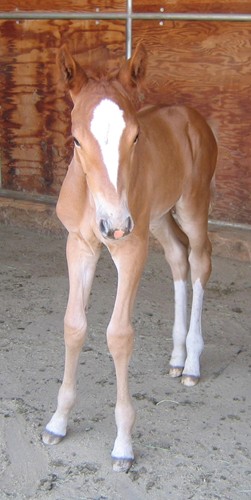 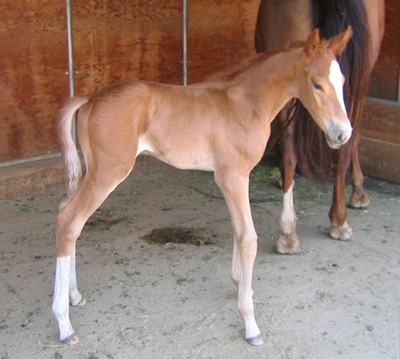 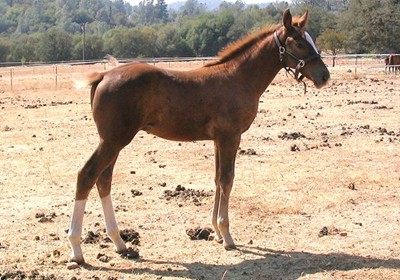 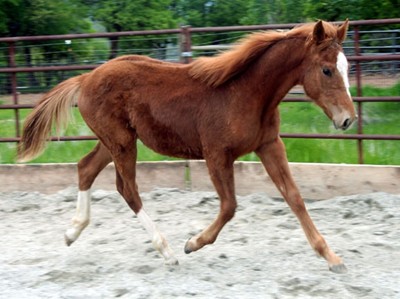
|
| New Member: kshayden |
Posted on Thursday, Jun 5, 2008 - 1:24 am: Thanks for sharing these. I hopefully just sent 3 photos to Sara that she can post - very nice of her to help me with the pic's and everyone else for their assistance. Kathy |
| Member: sdms |
Posted on Thursday, Jun 5, 2008 - 8:43 am: Good morning. Here are the pictures Kathy sent. I don't have any experience in this area so this is about the only assistance I can offer. Best of luck,Kathy!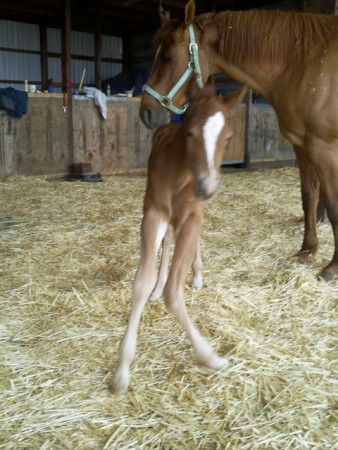 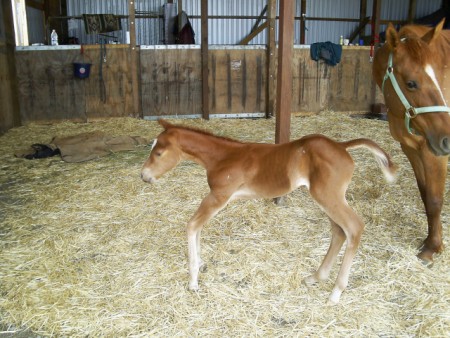 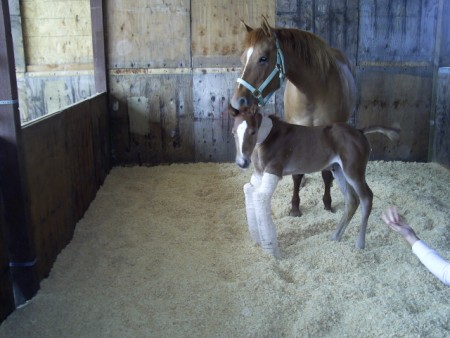
|
| New Member: kshayden |
Posted on Thursday, Jun 5, 2008 - 12:19 pm: Fantastic Sara. Thank you for posting these photos.The first two he is about 10 hours old. He left shortly after for the neo natal care facility. The last photo, he had his 2nd set of splints, so that photo he is less than 2 days old and just arrived back home. As you can see, he has two types of angular deformities. Any assistance would be much appreciated. Kathy |
| Member: sureed |
Posted on Thursday, Jun 5, 2008 - 1:09 pm: Kathy,I am so sorry you and this colt (and his Mom) are going through this. Clearly, this is a case that needs to be managed in close consultation with a veterinarian. From your post, it sounds that you are making progress. When I was doing research on this issue because one of my 06 foals was down on his heels behind, and again because of Cappy's knees in 07, I saw some pretty alarming photos of foal leg deformities that one would think would never correct but the after photos show remarkable recovery. Do you have any recent pictures of the colt un-splinted? Feel free to email to me if you need to for posting. My email is on my profile. Suzanne |
| Member: marciaw |
Posted on Thursday, Jun 5, 2008 - 2:53 pm: Kathy,Some of my caution with my colt this is because last year we had a lovely grulla filly born to a different mare and stallion. We sort of inherited this mare right before she foaled. When the filly was born I was so excited by her beauty and her color. We were hoping for a filly so we could breed her back to our stud. She had a bit of a knock knee on one side and everyone told me she would straighten out. I tried penning her mother, but she was very nervous and would not quit pacing. I wish I had given her more time. I turned them out and the filly's leg just got worse. I was giving the filly rejuvenaid twice a day. We were quite busy at the time and I didn't take her to the vets as it is such a long distance. Now I have a lovely grulla filly with one very knocked knee. She is still running with the rest of the yearlings, but I am so ashamed that I didn't take her in and have her leg splinted. She will never be ridden. Live and learn. I'm so sorry about your little guy. I know how I anticipate the arrival of the few we have each year. I guess all we can do is our best and not let worry rob us of the joy. We are all rooting for you and your colt here at the ranch!!! Marcia |
| New Member: kshayden |
Posted on Thursday, Jun 5, 2008 - 4:49 pm: Thanks Marcia and Suzanne. As of Tuesday night, my vet said he needs surgery. I have read that they can only correct one leg and by the time that one heals, it is too late to fix the other. any thoughts.His knees are really swollen and he seems outchy.I have heard that giving vitamins A D & E are really beneficial. Anyone hear of this? My vet hasn't said anything about my mares diet, but friends are telling me to get her junk grass hay and don't give her anything else so the foal slows his growin. It is so hard to watch him in a stall. He so wants to go kick his heals up and be normal. Course, in his little 14 x 20 stall, he gets moving  My mom insists that I am doing more harm keeping him up (she comes from a long line of horse folks), but recent studies seem to agree that stalling is the best. My mom insists that I am doing more harm keeping him up (she comes from a long line of horse folks), but recent studies seem to agree that stalling is the best. The stallion is CTR Pepto's Gin Holly. A very lovely young horse. This is his first foal crop and of the 11 born, mine is the only one with issues. The rest are really nice. The mare had 3 foals prior and all of them were fine as well. I am taking a lot of flack for giving my mare too much nutrition during her pregnancy. I have never had any desire to breed. I bought this mare for my daughter. After about 6 weeks, she bagged up and I freaked. First thing Monday AM - off to the vets and to my relief, she was open. Well, that started alot of excitement and disappointment and the whole family was on a role of 'let's breed her'. I was out numbered. A friend of mine calls him a 'fun' foal. Guess that is a term given to people like me that doesn't do this for a living  ?? Not quite sure how anyone makes money these days. My vet bills are already $ 2200 - and he is 12 days old ?? Not quite sure how anyone makes money these days. My vet bills are already $ 2200 - and he is 12 days old  I will keep you all posted. I am anxiously waiting to hear from folks who have dealt with the severe deformities this guy has. Thanks a bunch. Kathy |
| Member: ekaufman |
Posted on Thursday, Jun 5, 2008 - 9:34 pm: Hi Kathy,It's a cautionary tale against "fun" breeding for sure. If this foal were mine, I would surely be very concerned. I have a mare who tends to produce windswept foals. Here is a photo of the most twisted one at 3 days old. This was not as severe as your foal by any means. She was radiographically normal (believe it or not) and has grown into a very correct and athletic 2 year-old. She experienced some soft tissue strain when I let her run too much as a baby, but never showed joint pain or swelling. That would have worried me a lot. I attribute much of her success to nature and to near-daily trimming of her feet to ensure that her hoof landed flat and did not re-enforce the deformity. That trimming has become religion in my program. 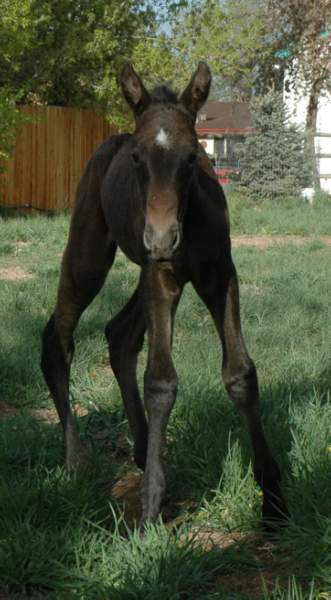 Good luck with your guy, and let us know what you decide and how it works out. |
| Member: sureed |
Posted on Thursday, Jun 5, 2008 - 10:11 pm: Kathy,I've never dealt with the conditions you are dealing with now, so can only advise that you be guided by your trusted vet's advice. As Elizabeth's photos show, there are certainly cases of remarkable recovery from leg malformation. But as DR. O has advised, there is a difference in recovery rate based on the degree of malformation. Those of us who are not vets can only share our experiences and not give you medical advice. We can only offer hope and support. Please keep us advised and know we are wishing you the best. Suzanne |
| Moderator: DrO |
Posted on Friday, Jun 6, 2008 - 8:14 am: First let's get the diagnosis right. Just noting the abnormalities does not explain which of the multiple possible causes exists.I only see one angular deformity: severe left carpus valgus. But what is the reason? There are a number of causes with different treatments and prognosis and differentiating them fairly easy with exam and radiographs. See the article for a description of the various causes and let us know what type your foal has. Now we also have moderate to severe bilateral flexor tendon contracture. However it is not clear exactly which tendons are contracted. Most importantly is whether the carpal flexors are involved with the digital flexors. Again the article explains the various possibilities and how to differentiate them. I have not heard of any related surgeries that can only be done on one side at a time and then it will be too late for the other side. Neither will vitamin supplementation be on any benefit unless there are deficiencies in the mares diet, and in the case of ADE unlikely if any green forage is available. So what we need here to be of help is: a precise diagnosis of what is causing the deformities. In the meantime very good support, particularly laterally and medially to protect against the uneven pressures of the valgus is essential to preserve the joints health until these legs can be straightened. DrO |
| Member: kshayden |
Posted on Friday, Jun 6, 2008 - 12:23 pm: Thanks DrO.I apologize for not having the in depth knowledge to explain the conditions. My vet said the carpus valgas can not be assisted with bandaging/splinting for support because it is not a tendon issue, but a bone issue. Could he be helped with bandaging? Both knees have different locations of swelling. The left knee has swelling on the outside and front with the front being hard, side softer. The right leg has swelling on the inside and front (that baffles my vet), both hard. Both knees are warm. This is why the vet said to discontinue use of the splints or wraps. He also has a bandage sore on his right coronet and she wants that to heal. (note: most articles I have read said to splint from just below the elbow to fetlock, but his splints actually went to the ground). At birth, he couldn't get his right ankle/foot in front of him and drug it so the sores could be a result of that initial trauma, just didn't show up for a couple of days. He now stands on his feet, but still very crooked. I haven't seen him miss step in a couple of days (he sometimes landed on the front of the fetlock instead of his hoof) We have been trimming the outside ever so gently. His contracted tendons have continued to improve, probably 90%, however, he kind of swings the right leg instead of bending and bringing forward (swelling causing this?). The vet explained he is a huge baby and that caused the contracted tendons and then adding the fact that he was 13 days early (ultrasounded at 23 days and present during breeding dialed in the 'standard' due date). She said the placenta was enormous as well and she was shocked it all came out of my mare. The carpus valgas wasn't present at birth but seemed to appear in the next few hours. It appears there are multiple issues here. Contracted knee AND fetlock tendons that continue to improve, swollen knees (left knee extensor tendon rupture, right knee?), carpus valgas severe in left, mild in right. Thank you DrO. It means alot to have a specialist educate me. I want to do this right to give this little guy the best chance at being sound. I know the future is hard to predict, but would love to get opinions on complete recovery of these issues. I really need to know if this guy is going to have a good quality of life/prognosis. My attending vet is a repro specialist and deals strictly with gestation and foals. She is also a thoroughbred breeder. Thanks so much. Kathy, Peaches and little Rocket Man 
|
| Moderator: DrO |
Posted on Friday, Jun 6, 2008 - 5:18 pm: We need to understand the cause of the carpal valgus Kathy. The article on angular deformities outlines at least 2 different bony issues and a possible soft tissue issue (that it is not clear has been ruled out) that result in carpal valgus. The history or the valgus developing several hours after birth is not consistent with typical congenital problems...Before you can proceed you need to be clear on which one your foal has. Have you read about the possibilities and have radiographs been taken? However no matter what the cause the abnormal forces across the joint and needs to be splinted to ameliorate the unbalanced forces acting on the soft tissues and cartilage surfaces. This is basic and not providing support may lead to further soft tissue injury and arthritis. Splinting will not cure the problem but keep the tissues healthy while correction takes place.Kathy you need to have a frank discussion with your veterinarian and if (s)he is a bit overwhelmed consider a referral to a equine hospital where these issues can get worked out a treatment plan, cost, and prognosis formulated and from there you can make decisions on how to proceed. DrO |
| Member: kshayden |
Posted on Tuesday, Jun 10, 2008 - 10:10 am: Hi DrO,The vet is coming out tomorrow to do x-rays on the knee and also to do the tendon stripping on both legs. My question. How do I support his knees? Should he wear splints? He has not had splints on for over a week. Legs seem better, however his knees look bad and he seems to be painful, especially in the left knee. Vet thinks it is just mechanical, not painful? He moves very stiff with little flex from the knee or fetlock, just kind of swings forward. If we splint him, where should the splints be? From just below elbow to fetlock or just around the knee? I understand that splints can keep his legs straighter up and down, but they do not allow his knees to bend and I am confused to whether his knees should be isolated with splints or left to move freely so they don't freeze. Both vets splinted front or back. It seems to me that he should be supported inside to outside instead which would allow some bending/movement of the knee, but still supported. As soon as I get the word on the x-rays, I will post that, but while he is out for surgery, it would be a good time to splint if we are going to and I would love to know the best way to do this. He is now 18 days old and getting harder every day to hold still for any length of time to doctor him. Also, is there a topical we can put on his legs to make him more comfortable (linament etc). Since he doesn't bend his joints, should he be on any medicine that either relieves pain or anti-inflamatory? Thanks so much for everything. The more I know, the more I can prepare. Kathy |
| Moderator: DrO |
Posted on Wednesday, Jun 11, 2008 - 8:00 am: Kathy these are all decisions that have to be made looking at the foal at the time of treatment and understanding the underlying pathologies so we are unable to give specific recommendations. In general you want to splint in a manner that creates forces that pull/push the leg in the direction of straightness. Ditto as to what type of topical or systemic drugs might be needed to improve this foals healing and quality of life. Do let us know how these decisions are made and we can discuss the strengths and weaknesses of the reasoning.DrO |
| Member: kshayden |
Posted on Wednesday, Jun 11, 2008 - 10:05 am: Thanks Dr.O.I will know more tonight after the surgery and xrays. I sure hope this little guy doesn't have permanent damage to his knees, especially if it is from something I didn't do right. It is so hard making these decisions. It always seems when I consult someone - the only thing they agree on is the other one is doing it *different* than they would. i.e. Keeping him stalled or not, changing the diet or not, keep bandages/splints on or not etc. At best, when 5 people say this - and 2 something different, you just go with the majority - Kathy |
| Member: ekaufman |
Posted on Wednesday, Jun 11, 2008 - 12:46 pm: Hi Kathy,Oh majority rule is maybe not the best way to call this one. The characteristics of good advice are not that you hear it a lot, in this case, but that it is based on good data, expert training, and shared goals for the animal (caveat budget issues etc.). When I dealt with the filly pictured above, I got a lot of input from everyone who saw her. In retrospect, most of it made no sense at all. What worked for me was first to find qualified experts (at a referral hospital) who could gather very good data on the internal structure of the legs. In my case, I was able to go to Littleton Large where they have a fabulous standing digital x-ray, and fancy software to analyze the images (compare angles and other measurements), and an expert surgeon who very patiently explained everything to me so that I could make a sound decision. I would encourage you not to pay for/subject the colt to a surgery that has not been clearly explained and backed up with very good x-rays. Sometimes that means being a bit hard-headed, but it's part of the job description in this case. Good luck with it. |
| Moderator: DrO |
Posted on Thursday, Jun 12, 2008 - 6:38 am: Kathy, educate yourself on the condition, that is really what Horseadvice is about, then follow your veterinarians advice. But as Elizabeth says above, question the why's and what-fores of everything until you understand what is going on...and approve.DrO |
| Member: marciaw |
Posted on Wednesday, Jun 18, 2008 - 11:35 am: Hi Kathy,I am just checking in on you to see how you are doing. I have thought of you often and I hope what ever is happening with your foal that you and yours are doing alright. Sincerely, Marcia |
| Member: kshayden |
Posted on Wednesday, Jun 18, 2008 - 12:50 pm: Hi Marcia,I hope your baby is doing well. His pictures look much better. Our baby was born on May 24th at 10:30 PM. I think ours are close in age? My guy - well, let's just say that he is a challenge. He had surgery Wednesday, stripping his tendon's on both front legs - he was only under anestetic for 20-25 minutes, I am not good with the names but the vet used ketamine, rompum and GG?? He became rigid, but no one noticed really. We all stood around talking waiting for baby to wake up. - he was cold and hard - etc...long story, his eyes were open but couldn't move - or be moved, even his neck or feet he was so stiff. His eyes ticked back and forth - we wrapped him in blankets so tight, he looked like a horse pinata  . . The vet called several other vets, including the neonatal care facility that had originally treated him (and also anesticized him) and no one had hear d of this or knew what to do. The vet put another cathedar in and shot IV fluids through him - but had to be cautious since he hadn't peed. One vet said to try valium - another Vitamin B - so he also received shots of these. No obvious difference. The vet left after about 4 hours - as there was no change and nothing she could do. She left bags of fluid and instructions. about 8 hours after surgery - he lifted his head and nickered at mom, who this whole time was standing patiently at his side - poor girl. His neck was freer and you could bend one back fetlock. progress !!! the night was long and hard as he did finally wake up - but very violently. 2 of us held his legs to keep him for injuring himself more as he thrashed and tried to keep the pillows and sleeping bags around him but he could fling em far with those legs. He ran in place for about 2 1/2 hours - resting inbetween. We nursed mom and fed him through a syringe - at first, it just ran off his nose, but then he started to beg for it - and eventually was able to swallow, though his tongue lay motionless out of his mouth. He was too stiff to sit up, so the milk couldn't be given too much but he was hungry for sure and mom had a constant squirting flow. Geez, he did finally get to his feet but then it appeared we were right back at day one - he couldn't stand on those front legs at all. He got stronger throughout the morning - then we get a call from the vet 'don't give up on that baby - his knees are prefect'. (we had done x-rays prior to surgery to check his knee issues) and so the day started looking up  . . I did speak with a large breeder on Monday that stated she had seen this with premee babies before . and she contributes all his issues with the fact that he was so early. I sure hope he can grow up and be healthy. Now, no vet wants to castrate him - too much fun. Oh, his legs you ask, well, they are actually improving every day. There is still a slight bend in his right knee (rupture swelling going away as well) and his left leg that went both directions - is straight up but still cocked out to the side - but not very much. The large inside bump on his left knee is fluid - He appears to be really sore and walks gingerly - might be from the surgery - but more than likely from the horrible trauma to his body. It took him about 1 1/2 hours of standing and falling to finally stand. Lots of trauma - though we tried so hard to catch him and get stuff under him. Aren't you glad you asked  . . It breaks my heart that he isn't perfect, but he makes up for it with personality. His mom Peaches should get a medal for all she has gone through with the human intervention and through it all has remained easy and calm and never left his side. Oh my gosh, his goal when he got on his feet was food - he couldn't stand really and Greg and I were trying to help him - it should have been taped - he was crashing into her legs - going between her front or back legs - bouncing in every direction and mom just raised her belly and hung in there for the crashes and even moved with him trying to help balance him. What a sight. Anyone ever seen this and what should I expect for future medication fears? Thanks, Kathy |
| Member: kshayden |
Posted on Saturday, Dec 6, 2008 - 10:13 am: HI again,Well, my little Rocket is now 6 months old and after exhausting non evasive treatments trying to stretch his tendons, he will be having surgery to cut his flexor tendons on both legs. xrays show a slight club foot on left front and slight damage to right knee caused by the splints being put on the front of his legs and chronic issues with RF coronet also caused by the splints on the front instead of the back of his legs. He has no toe and is uncomfortable walking so this is a last ditch effort to try and save this little guy. My shoer, bless her heart, has offered to take him to her house so he can have trims and shoes every 2 weeks post surgery (she lives a couple of hours away and can't come to my home that often, but is the best in the area) I would love to hear from folks that have had this surgery done at or around this age - What problems and treatments were encountered and what the outcome was. Everyone that knows Rocket is pulling for him. He is a puppy dog and has such a will to live. Thanks to everyone. Kathy |
| Member: dres |
Posted on Saturday, Dec 6, 2008 - 10:51 am: I don't know Rocket, but I TOO am pulling for him.. what a QT colt..Please keep us up dated and more pictures too.. COME ON ROCKET MAN... On the first day God created horses, on the second day he painted them with spots.. |
| Member: frances |
Posted on Saturday, Dec 6, 2008 - 2:21 pm: Phew, Kathy, what a fight you've had to get this sweet boy straightened out.Best of luck for a fully successful outcome to the surgery. |
| Member: mrose |
Posted on Saturday, Dec 6, 2008 - 9:57 pm: I'm just reading through all this, Kathy. I ready your earlier posts, but since I've had no experience with such an issue I've just been reading and not commenting. What a lot you and Rocket both have been through! I also would love to see more pictures. Best of luck with the upcoming surgery. Please keep us posted. |
| Member: kshayden |
Posted on Sunday, Dec 7, 2008 - 12:28 am: I would love to post pictures but still haven't been able to figure it out. The picture has been resized to 23.3 KB, far below the 64 KB requirement, but it still errors. File size is 303 x 222. Just don't know how to make it work. Sorry.Thank you for all the good thoughts for Rocket. Kathy |
| Member: dres |
Posted on Sunday, Dec 7, 2008 - 12:44 am: Kathy email me your pictures i will down size them and post em for you.. email is my profile..On the first day God created horses, on the second day he painted them with spots.. |
| Moderator: DrO |
Posted on Sunday, Dec 7, 2008 - 4:32 am: Kathy, I have had foals with bilateral DDF tenotomy go on to make sound trail and successful lower level dressage horses.DrO |
| Member: lilo |
Posted on Sunday, Dec 7, 2008 - 1:14 pm: Kathy, I just want to add good wishes for Rocket. Dr. O's reply sounds a hopeful note.Lilo |
| Member: dres |
Posted on Monday, Dec 8, 2008 - 1:01 am: 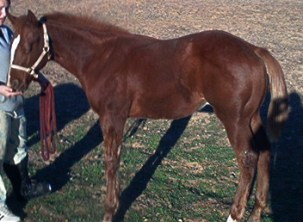 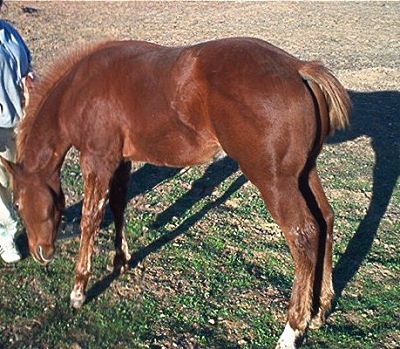 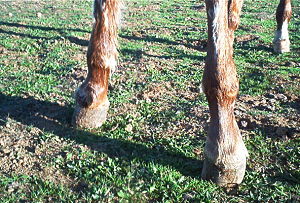 Rocket for Kathy Rocket for Kathy
|
| Member: kshayden |
Posted on Monday, Dec 8, 2008 - 10:13 am: Dr. O,I took these right after we soaked, hosed and applied treatment to the coronet on RF. Which is a rodeo at times. He doesn't like the bucket, the hose ect... From the leg shot, can you tell how his LF is growing crooked out from the fetlock? The hoof grows in the same line then in the middle of the hoof, goes down straight. The RF has damage to the coronet band and had popped open, probably due to the moisture from soaking in the Davis boots. He is very painful on these legs but walked much better with the Davis boots on. He has thrush and has had absesses as well. All the white on his legs are scars from the bandaging. Will that ever go away? Any knowledge of how long corrective shoes need to be worn after the surgery? I realize it is a case by case basis but I am adding up yet another expensive treatment for little Rocket. Unfortunately, at this time, we are starting to wonder how much we should put him through and when to say when. It is just me, on a clerical salary, maintaining a home, horses and dogs on 20 acres in CA.... Thanks, Kathy |
| Member: kshayden |
Posted on Monday, Dec 8, 2008 - 10:14 am: Thank you so much Ann for posting these photos.Kathy |
| Member: ekaufman |
Posted on Monday, Dec 8, 2008 - 1:44 pm: Hi Kathy,Only you and your family, with input from your veterinarian, can really assess whether and how far to continue with Rocket. If you read the boards, I think you'll see that hard decisions are part of horse ownership, and they are very personal. Your goals and resources are absolutely an important factor in your decision-making, along with his current and future quality of life, etc.. Just because something can be done does not make it always the best choice under the circumstances. Maybe it will help for me to tell you this-- I have occasionally gone too far trying to save a horse, and have regretted it. I've wasted money and put horses through extended periods of suffering that led nowhere. I've also lost horses through avoidable illness or injury or mistakes, and regretted that too. So my decisions when to stop are very personal, though I do consult with my veterinarian, and I know through my own experience that "no" can be a fine answer sometimes, even if it feels a bit villainous to say it. HA is a great community that doesn't stand in judgment, whatever you choose. Let us know so that we can support you either way. - Elizabeth |
| Moderator: DrO |
Posted on Tuesday, Dec 9, 2008 - 9:13 am: Hello Kathy,As to the scarring getting better, the images are not clear enough on this issue for me to evaluate but the white hair will probably remain. Corrective shoes must be done on a case by case basis. Following DDF tenotomy I have seen foals under correct, be just right, and over correct. Most over correct with the foal rocked back on the heel and the toe elevated in the air but this foal is a little older than those I have done. If you get under correction or over correction you will need corrective shoeing to support and promote proper conformation until the hoof and pastern support themselves in a proper angle and I really cannot guess how long that might be. Pain in these cases is almost always bruising at the toe and after this much time I would also be concerned about possible degenerative changes at the tip of the coffin bone. DrO |
is The Horseman's Advisor
Helping Thousands of Equestrians, Farriers, and Veterinarians Every Day
All rights reserved, © 1997 -
